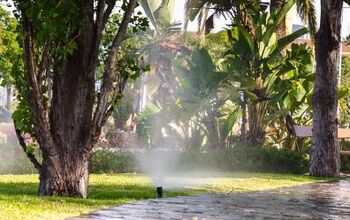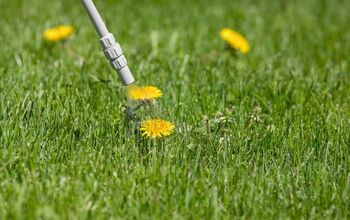How Many Sprinkler Heads Should You Have Per Zone?

Sprinklers are a highly useful tool for keeping a yard or garden properly and consistently watered. They can even be scheduled and automated so that they require little intervention from the user. At the end of the day, they are quite effective for proper yard and garden care.
It is important, however, to know how many sprinklers can be used per zone or valve. This is because the sprinkler head will consume different quantities of water. Knowing the pounds per square inch (PSI) and the gallons per minute (GPM) will tell you how many sprinklers that you can have per zone.
Do You Need to Hire a Sprinkler System Contractor?
Get free, zero-commitment quotes from pro contractors near you.

How Many Sprinkler Heads Per Zone?
There isn’t a universal chart for figuring out how many sprinkler heads that you can have on a given zone or valve. This is entirely dictated by the flow rate and pressure of the water supply running through your property.
While that is relatively straightforward, it is the sprinkler heads that can vary. Depending on which brand that you go with, they can have different specifications that alter the calculations. It is easier to stick with a single brand so that calculations are easier, though costs can definitely play a factor.
Pounds Per Square Inch
Knowing the water pressure of your home water system isn’t quite as complicated as your gallons per minute calculations, but it will require some special equipment. In order to properly measure water pressure, you need to have a pressure gauge attached to the outside faucet that is located the closest to your water meter.
To effectively gauge water pressure, make sure to turn off anything inside of the house that will be using water before cranking the specified faucet to full. Record the reading on the gauge; this should be in pounds per square inch for simplicity sake.
Worst case, you can call the water company and they will tell you what kinds of sprinkler heads will work given your current water supply. Under no circumstances should you use a sprinkler head that has a PSI range under or over what your water system is.
Gallons Per Minute
The other important measurement when determining the capabilities of your irrigation system is to find the flow rate. This measurement is calculated in gallons per minute. This measurement you can take yourself relatively easily.
All you need is a bucket with a known size, something like a gallon or five gallons in size. Make sure that you turn anything off that uses water both inside and outside of the house. Put your bucket underneath the outside faucet and turn it on full blast.
The goal here is to measure, in seconds, how long it will take to fill up the bucket. When you have this, you can calculate the flow rate by multiplying the bucket size by 60 and then dividing the by the time that you clocked in seconds. So, if it took 18 seconds to fill a 5-gallon bucket, your math would be 5 x 60/18, which equals 16.67 GPM.
How Do You Calculate Zones?
Now that we have the two major calculations in hand, there is one more step before you can know how many sprinklers go into each zone. You have to figure out how many sprinkler heads that you’ll need in total.
Start out by mapping your yard out. Know where sprinklers will be needed based on the direction and the distance of their spray. Within each zone, there should be indications of the plants that will require watering and/or the area of the lawn.
When you have this, add the flow rate in GPM for all of the sprinkler heads and divide by the GPM of your current water supply. The number that comes out of this will indicate how many different zones that you need. So, if you determine that each sprinkler needs a GPM rate of 1.5 and you have 20 of them, you’ll need a total of 30 GPM. If the sprinkler system can only handle 16, you’d need two zones to cover that entire area.
What If Water Sprays Weakly From Your Sprinklers?
Maybe you’ve run into a situation where the sprinklers have been weaker than you thought with a shorter overall spraying distance than what the manufacturer says. This is a good indication that you have too many sprinkler heads in one zone.
Keep in mind that the zone will run all of the heads at a single time. If you have too many sprinkler heads in one zone, it will lower the pressure for each of the heads involved. The first thing to do in the event of poor performance is to remove one of the heads.
It is a good idea to avoid combining sprinklers that have varying flow rates to them. This will mean that they use different amounts of water all at the same time, making it more difficult to properly gauge how many zones you need and how many heads are needed per zone.
Avoiding Pressure Dips
Here’s a simple tip for getting more consistent pressurized water flow out of your sprinkler heads. Whatever the run time of your zones, cut that in half and simply run your watering program double the amount instead.
So, if you have 30 minutes of watering time for each zone, try watering for 15 minutes once, allowing for all of the zones to cycle. When the cycle is complete, run it again for another 15 minutes. You get the same amount of watering time but with improved efficiency out of the spray.
How Often Should You Water the Lawn?
There are a lot of misconceptions out there about how frequently you should be watering your lawn. Watering daily will likely prevent the grass from being able to dry out thoroughly enough and it will basically flood the grass.
The same goes for watering your lawn at night. Without proper evaporation, pathogens can then permeate the grass. This will do long-term damage to your grass and can cause major issues throughout such as shallow roots.
Try to water your lawn two to three times per week. By watering every few days, you give the grass the proper evaporation opportunities. Your soil moist should be at a depth of around 5 or 6 inches at most; watering daily will cause the aforementioned shallow roots which can provide extra stress on your grass.
Run The Sprinklers in the Morning
The best time for the sprinklers to run is early in the morning, preferably before 10 AM. The entire point of this is to allow for proper evaporation throughout the day. This is why it is so bad to water at night.
The cooler temperatures of the morning, in tandem with calm breezes and less harsh sunlight, allow for just enough evaporation to prevent pathogens from permeating the yard.
Watering in the morning also helps to keep the ground cooler during the hotter parts of the day. When the grass is cooler throughout the mid-to-late afternoon, there is far less stress put on the grass. Healthy, lush, green lawns generally have a proper watering schedule and work to reduce the amount of stress felt by the grass.
Types of Sprinkler Heads
Traditionally speaking, sprinkler heads are placed into two broad categories based on the way that they distribute water: rotor type sprinklers and spray type sprinklers. However, the emergence of new technologies has begun to blur the lines between these traditional types.
- Rotors: This is the term used to describe a variety of sprinkler heads that function by rotating streams of water in circles or a back-and-forth motion across a lawn. The rotor sprinkler that most are familiar with are Rain Bird sprinkler heads.
- Spray Heads: More often called “fixed spray heads,” these sprinkler heads are smaller and spray water in a fan-shaped pattern, similar to a shower nozzle. Many spray heads offer the option of interchangeable nozzles to determine the specific pattern – ½ circle, full circle, etc.
Do You Need to Hire a Sprinkler System Contractor?
Get free, zero-commitment quotes from pro contractors near you.

Wrapping It Up
The number of sprinkler heads that should be included in a zone, or on a singular valve, is determined based on the flow rate and pressure of your water supply. Flow rate is measured in gallons per minute (GPM), while water pressure is measured in pounds per square inch. Once you calculate each, you will be able to find out how many heads can service a zone.
For best results, avoid combining different brands of sprinkler heads. This can have unexpected consequences, even if you are meticulous about sticking to manufacturer’s recommendations. To ensure the most accurate calculations, always stick to one brand.
Related Questions
Can you mix and match sprinkler heads?
While some experts suggest that you can mix different brands, this is not always recommended. Also, you want to avoid combining the type of head, as each will have a different flow rate. Spray heads, matched precipitation, rotor heads etc. all dispense water at differing rates.
How much should sprinkler heads overlap?
Believe it or not, sprinklers are designed to intentionally require 100% overlap of watered areas. Yes, this means that every sprinkler will distribute water all the way to the next, in each direction. This is absolutely essential to avoid dry spots.
Related Guides

Ryan Womeldorf has more than a decade of experience writing. He loves to blog about construction, plumbing, and other home topics. Ryan also loves hockey and a lifelong Buffalo sports fan.
More by Ryan Womeldorf













![10 Best Zero Turn Mowers – [2022 Reviews & Ultimate Buyer's Guide]](https://cdn-fastly.upgradedhome.com/media/2023/07/31/9070522/10-best-zero-turn-mowers-2022-reviews-ultimate-buyer-s-guide.jpg?size=350x220)













